Diabetes Type 2 Case Study: Pathophysiology, Treatment, and Management
VerifiedAdded on 2022/09/23
|10
|2607
|29
Case Study
AI Summary
This case study examines a 75-year-old male patient, Bill McDonald, diagnosed with Type 2 Diabetes. The assignment delves into the pathophysiology of the disease, including impaired insulin secretion and insulin resistance, exploring the impact of factors such as glucotoxicity and genetic factors. It analyzes the patient's symptoms, including fluctuating glucose levels and the impact of lifestyle choices. The study covers the patient's medical history, the importance of early intervention, and the treatment strategies, including lifestyle modifications, medication, and management of hypertension. The case study emphasizes the significance of comprehensive care, collaboration between specialists, and non-specialist physicians to improve patient outcomes, highlighting the need for close monitoring and adherence to treatment plans to prevent complications.
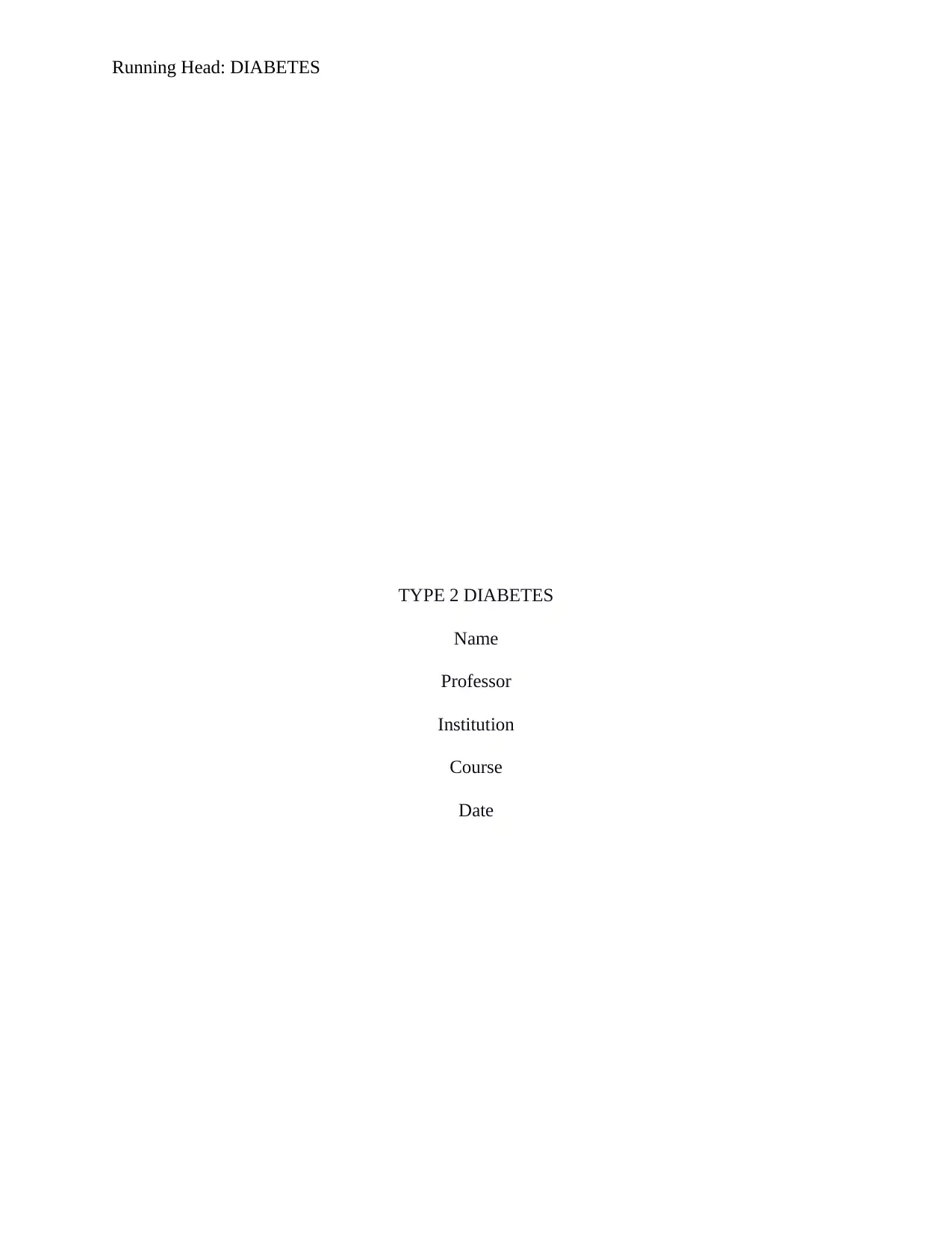
Running Head: DIABETES
TYPE 2 DIABETES
Name
Professor
Institution
Course
Date
TYPE 2 DIABETES
Name
Professor
Institution
Course
Date
Paraphrase This Document
Need a fresh take? Get an instant paraphrase of this document with our AI Paraphraser
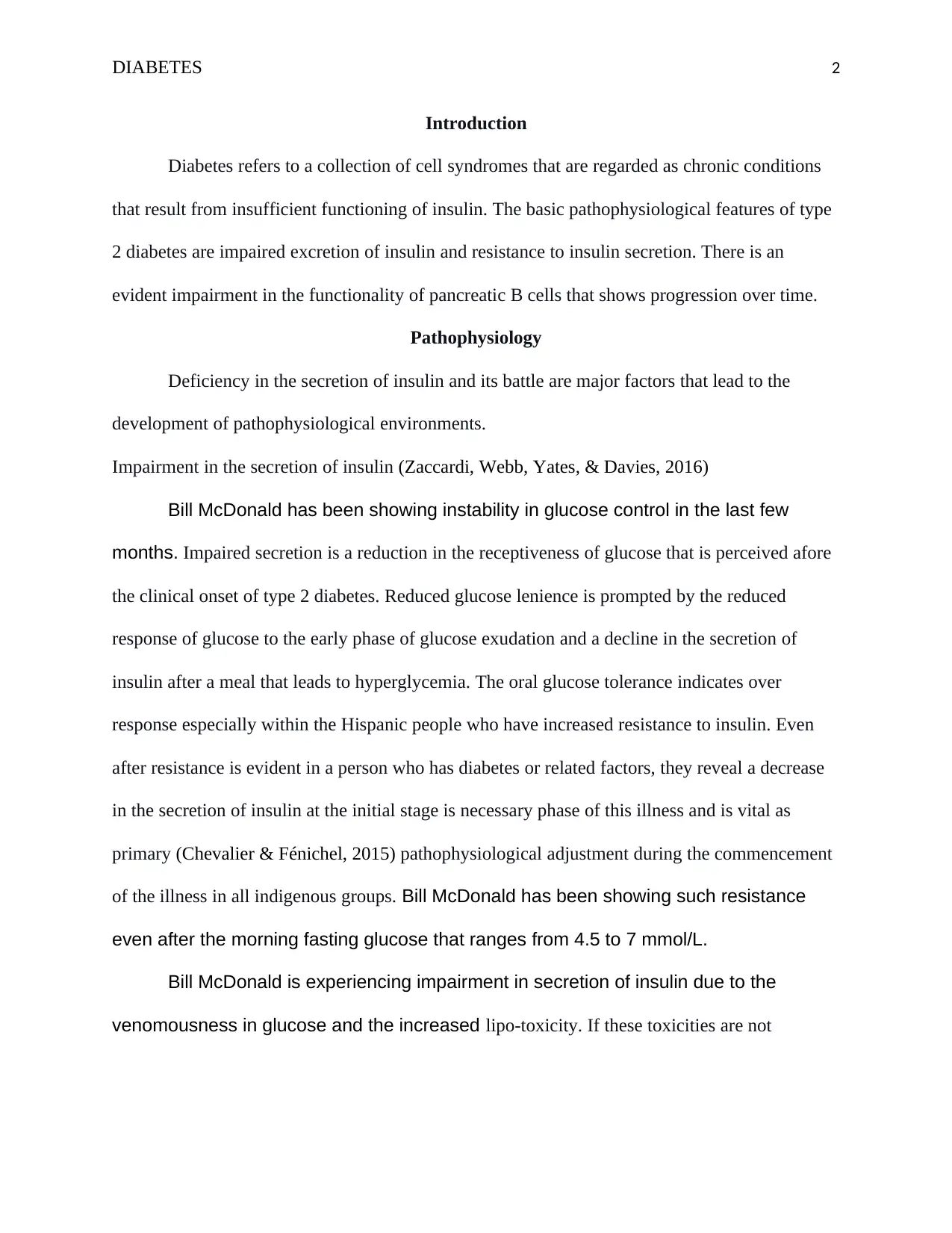
DIABETES 2
Introduction
Diabetes refers to a collection of cell syndromes that are regarded as chronic conditions
that result from insufficient functioning of insulin. The basic pathophysiological features of type
2 diabetes are impaired excretion of insulin and resistance to insulin secretion. There is an
evident impairment in the functionality of pancreatic B cells that shows progression over time.
Pathophysiology
Deficiency in the secretion of insulin and its battle are major factors that lead to the
development of pathophysiological environments.
Impairment in the secretion of insulin (Zaccardi, Webb, Yates, & Davies, 2016)
Bill McDonald has been showing instability in glucose control in the last few
months. Impaired secretion is a reduction in the receptiveness of glucose that is perceived afore
the clinical onset of type 2 diabetes. Reduced glucose lenience is prompted by the reduced
response of glucose to the early phase of glucose exudation and a decline in the secretion of
insulin after a meal that leads to hyperglycemia. The oral glucose tolerance indicates over
response especially within the Hispanic people who have increased resistance to insulin. Even
after resistance is evident in a person who has diabetes or related factors, they reveal a decrease
in the secretion of insulin at the initial stage is necessary phase of this illness and is vital as
primary (Chevalier & Fénichel, 2015) pathophysiological adjustment during the commencement
of the illness in all indigenous groups. Bill McDonald has been showing such resistance
even after the morning fasting glucose that ranges from 4.5 to 7 mmol/L.
Bill McDonald is experiencing impairment in secretion of insulin due to the
venomousness in glucose and the increased lipo-toxicity. If these toxicities are not
Introduction
Diabetes refers to a collection of cell syndromes that are regarded as chronic conditions
that result from insufficient functioning of insulin. The basic pathophysiological features of type
2 diabetes are impaired excretion of insulin and resistance to insulin secretion. There is an
evident impairment in the functionality of pancreatic B cells that shows progression over time.
Pathophysiology
Deficiency in the secretion of insulin and its battle are major factors that lead to the
development of pathophysiological environments.
Impairment in the secretion of insulin (Zaccardi, Webb, Yates, & Davies, 2016)
Bill McDonald has been showing instability in glucose control in the last few
months. Impaired secretion is a reduction in the receptiveness of glucose that is perceived afore
the clinical onset of type 2 diabetes. Reduced glucose lenience is prompted by the reduced
response of glucose to the early phase of glucose exudation and a decline in the secretion of
insulin after a meal that leads to hyperglycemia. The oral glucose tolerance indicates over
response especially within the Hispanic people who have increased resistance to insulin. Even
after resistance is evident in a person who has diabetes or related factors, they reveal a decrease
in the secretion of insulin at the initial stage is necessary phase of this illness and is vital as
primary (Chevalier & Fénichel, 2015) pathophysiological adjustment during the commencement
of the illness in all indigenous groups. Bill McDonald has been showing such resistance
even after the morning fasting glucose that ranges from 4.5 to 7 mmol/L.
Bill McDonald is experiencing impairment in secretion of insulin due to the
venomousness in glucose and the increased lipo-toxicity. If these toxicities are not
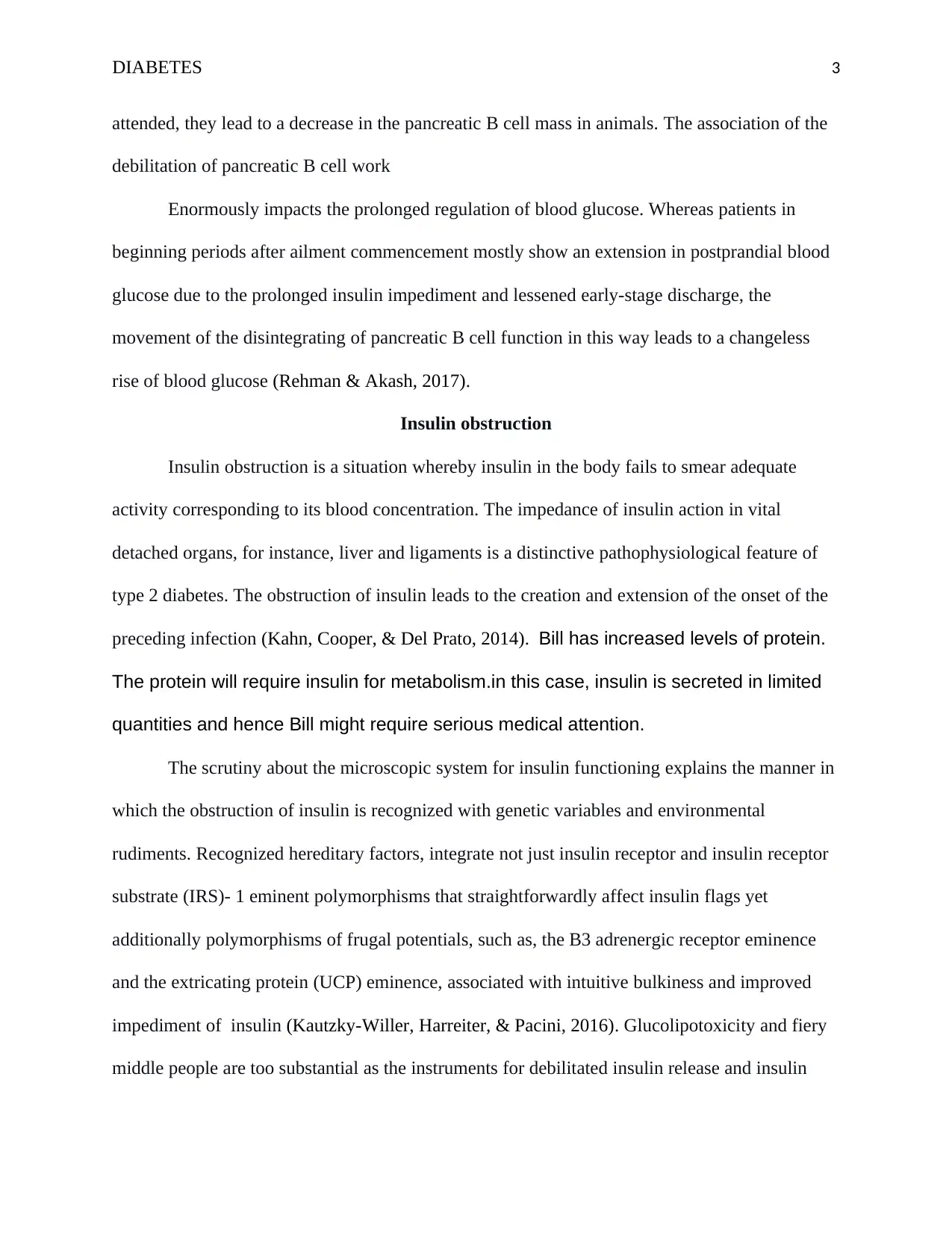
DIABETES 3
attended, they lead to a decrease in the pancreatic B cell mass in animals. The association of the
debilitation of pancreatic B cell work
Enormously impacts the prolonged regulation of blood glucose. Whereas patients in
beginning periods after ailment commencement mostly show an extension in postprandial blood
glucose due to the prolonged insulin impediment and lessened early-stage discharge, the
movement of the disintegrating of pancreatic B cell function in this way leads to a changeless
rise of blood glucose (Rehman & Akash, 2017).
Insulin obstruction
Insulin obstruction is a situation whereby insulin in the body fails to smear adequate
activity corresponding to its blood concentration. The impedance of insulin action in vital
detached organs, for instance, liver and ligaments is a distinctive pathophysiological feature of
type 2 diabetes. The obstruction of insulin leads to the creation and extension of the onset of the
preceding infection (Kahn, Cooper, & Del Prato, 2014). Bill has increased levels of protein.
The protein will require insulin for metabolism.in this case, insulin is secreted in limited
quantities and hence Bill might require serious medical attention.
The scrutiny about the microscopic system for insulin functioning explains the manner in
which the obstruction of insulin is recognized with genetic variables and environmental
rudiments. Recognized hereditary factors, integrate not just insulin receptor and insulin receptor
substrate (IRS)- 1 eminent polymorphisms that straightforwardly affect insulin flags yet
additionally polymorphisms of frugal potentials, such as, the B3 adrenergic receptor eminence
and the extricating protein (UCP) eminence, associated with intuitive bulkiness and improved
impediment of insulin (Kautzky-Willer, Harreiter, & Pacini, 2016). Glucolipotoxicity and fiery
middle people are too substantial as the instruments for debilitated insulin release and insulin
attended, they lead to a decrease in the pancreatic B cell mass in animals. The association of the
debilitation of pancreatic B cell work
Enormously impacts the prolonged regulation of blood glucose. Whereas patients in
beginning periods after ailment commencement mostly show an extension in postprandial blood
glucose due to the prolonged insulin impediment and lessened early-stage discharge, the
movement of the disintegrating of pancreatic B cell function in this way leads to a changeless
rise of blood glucose (Rehman & Akash, 2017).
Insulin obstruction
Insulin obstruction is a situation whereby insulin in the body fails to smear adequate
activity corresponding to its blood concentration. The impedance of insulin action in vital
detached organs, for instance, liver and ligaments is a distinctive pathophysiological feature of
type 2 diabetes. The obstruction of insulin leads to the creation and extension of the onset of the
preceding infection (Kahn, Cooper, & Del Prato, 2014). Bill has increased levels of protein.
The protein will require insulin for metabolism.in this case, insulin is secreted in limited
quantities and hence Bill might require serious medical attention.
The scrutiny about the microscopic system for insulin functioning explains the manner in
which the obstruction of insulin is recognized with genetic variables and environmental
rudiments. Recognized hereditary factors, integrate not just insulin receptor and insulin receptor
substrate (IRS)- 1 eminent polymorphisms that straightforwardly affect insulin flags yet
additionally polymorphisms of frugal potentials, such as, the B3 adrenergic receptor eminence
and the extricating protein (UCP) eminence, associated with intuitive bulkiness and improved
impediment of insulin (Kautzky-Willer, Harreiter, & Pacini, 2016). Glucolipotoxicity and fiery
middle people are too substantial as the instruments for debilitated insulin release and insulin
⊘ This is a preview!⊘
Do you want full access?
Subscribe today to unlock all pages.

Trusted by 1+ million students worldwide
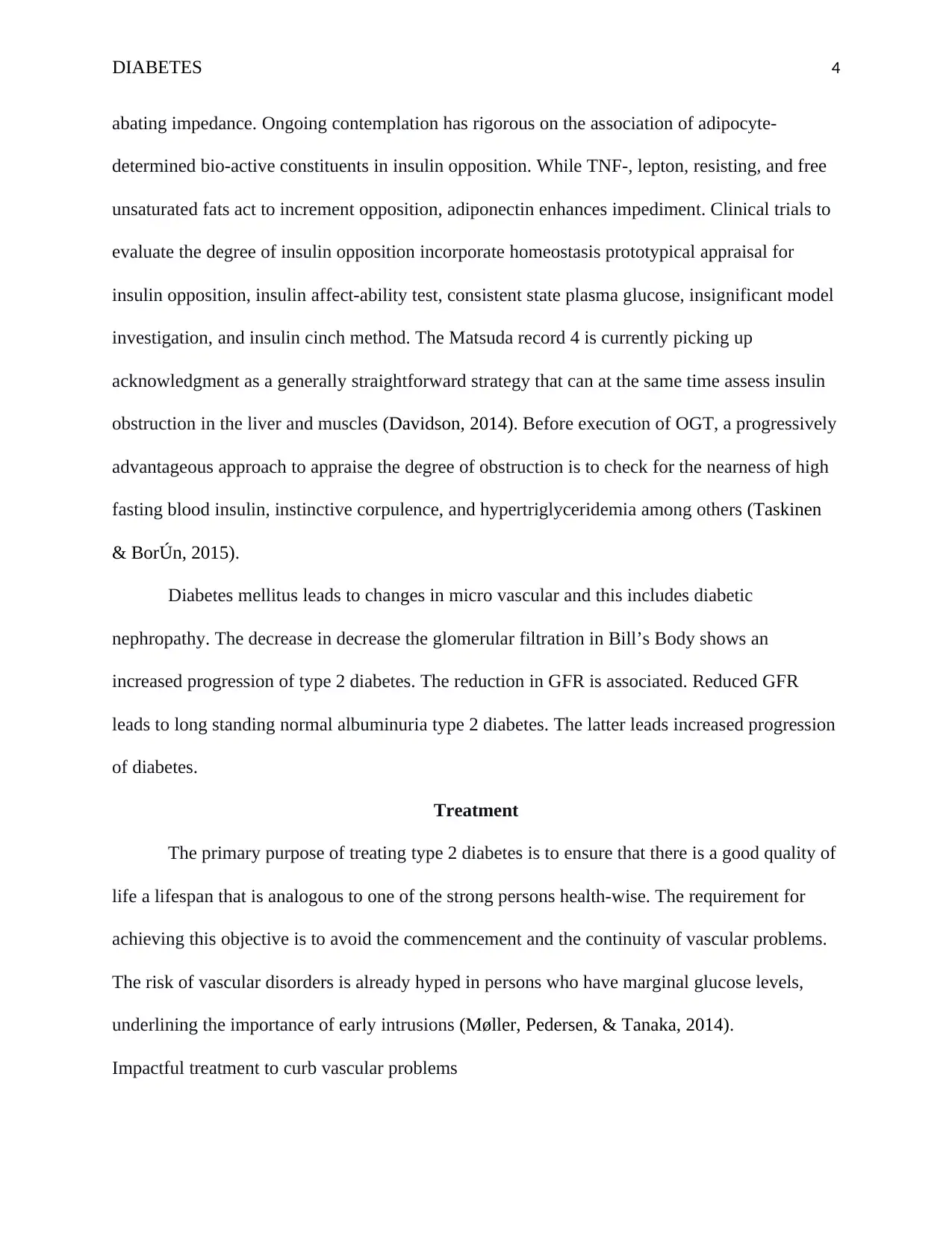
DIABETES 4
abating impedance. Ongoing contemplation has rigorous on the association of adipocyte-
determined bio-active constituents in insulin opposition. While TNF-, lepton, resisting, and free
unsaturated fats act to increment opposition, adiponectin enhances impediment. Clinical trials to
evaluate the degree of insulin opposition incorporate homeostasis prototypical appraisal for
insulin opposition, insulin affect-ability test, consistent state plasma glucose, insignificant model
investigation, and insulin cinch method. The Matsuda record 4 is currently picking up
acknowledgment as a generally straightforward strategy that can at the same time assess insulin
obstruction in the liver and muscles (Davidson, 2014). Before execution of OGT, a progressively
advantageous approach to appraise the degree of obstruction is to check for the nearness of high
fasting blood insulin, instinctive corpulence, and hypertriglyceridemia among others (Taskinen
& BorÚn, 2015).
Diabetes mellitus leads to changes in micro vascular and this includes diabetic
nephropathy. The decrease in decrease the glomerular filtration in Bill’s Body shows an
increased progression of type 2 diabetes. The reduction in GFR is associated. Reduced GFR
leads to long standing normal albuminuria type 2 diabetes. The latter leads increased progression
of diabetes.
Treatment
The primary purpose of treating type 2 diabetes is to ensure that there is a good quality of
life a lifespan that is analogous to one of the strong persons health-wise. The requirement for
achieving this objective is to avoid the commencement and the continuity of vascular problems.
The risk of vascular disorders is already hyped in persons who have marginal glucose levels,
underlining the importance of early intrusions (Møller, Pedersen, & Tanaka, 2014).
Impactful treatment to curb vascular problems
abating impedance. Ongoing contemplation has rigorous on the association of adipocyte-
determined bio-active constituents in insulin opposition. While TNF-, lepton, resisting, and free
unsaturated fats act to increment opposition, adiponectin enhances impediment. Clinical trials to
evaluate the degree of insulin opposition incorporate homeostasis prototypical appraisal for
insulin opposition, insulin affect-ability test, consistent state plasma glucose, insignificant model
investigation, and insulin cinch method. The Matsuda record 4 is currently picking up
acknowledgment as a generally straightforward strategy that can at the same time assess insulin
obstruction in the liver and muscles (Davidson, 2014). Before execution of OGT, a progressively
advantageous approach to appraise the degree of obstruction is to check for the nearness of high
fasting blood insulin, instinctive corpulence, and hypertriglyceridemia among others (Taskinen
& BorÚn, 2015).
Diabetes mellitus leads to changes in micro vascular and this includes diabetic
nephropathy. The decrease in decrease the glomerular filtration in Bill’s Body shows an
increased progression of type 2 diabetes. The reduction in GFR is associated. Reduced GFR
leads to long standing normal albuminuria type 2 diabetes. The latter leads increased progression
of diabetes.
Treatment
The primary purpose of treating type 2 diabetes is to ensure that there is a good quality of
life a lifespan that is analogous to one of the strong persons health-wise. The requirement for
achieving this objective is to avoid the commencement and the continuity of vascular problems.
The risk of vascular disorders is already hyped in persons who have marginal glucose levels,
underlining the importance of early intrusions (Møller, Pedersen, & Tanaka, 2014).
Impactful treatment to curb vascular problems
Paraphrase This Document
Need a fresh take? Get an instant paraphrase of this document with our AI Paraphraser
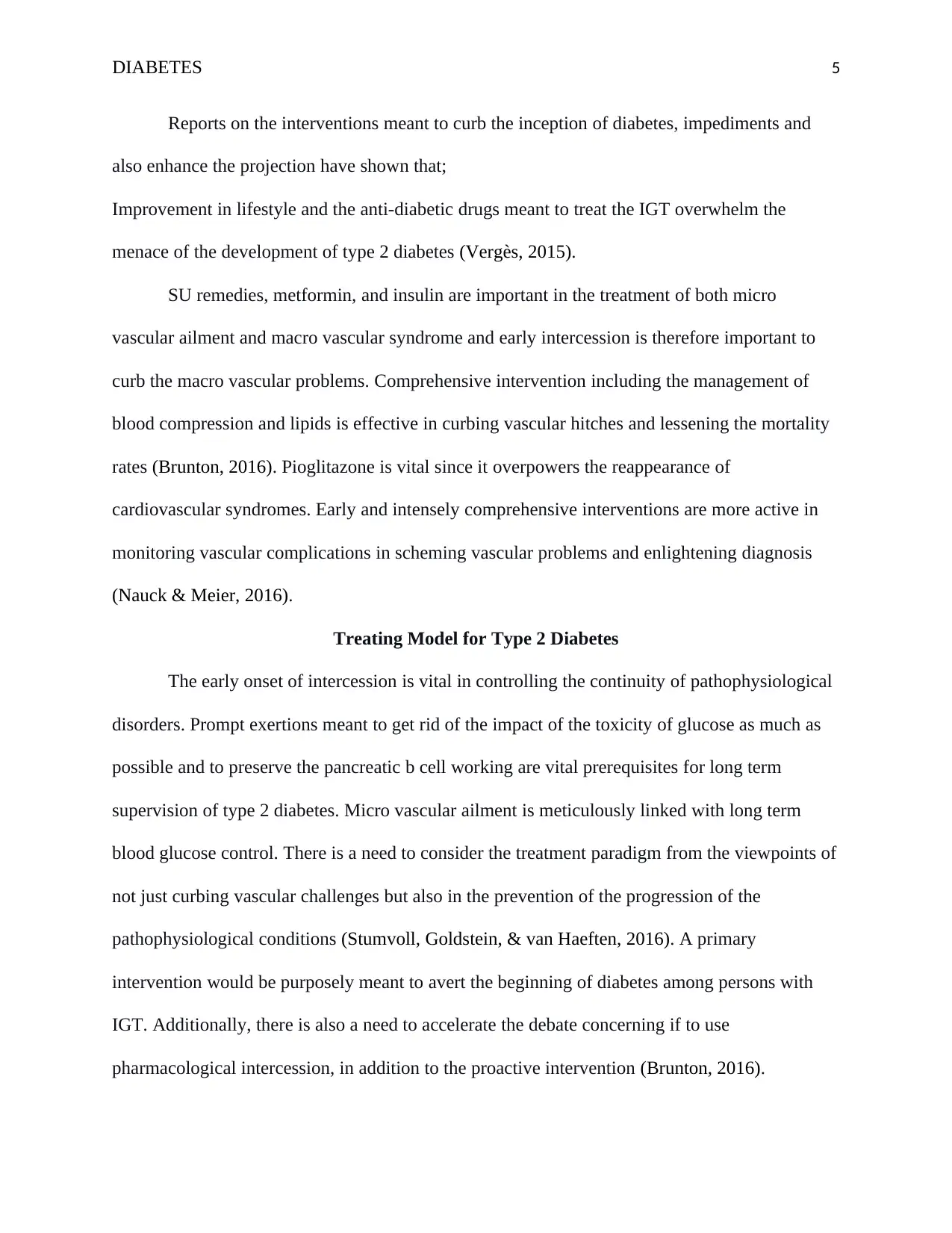
DIABETES 5
Reports on the interventions meant to curb the inception of diabetes, impediments and
also enhance the projection have shown that;
Improvement in lifestyle and the anti-diabetic drugs meant to treat the IGT overwhelm the
menace of the development of type 2 diabetes (Vergès, 2015).
SU remedies, metformin, and insulin are important in the treatment of both micro
vascular ailment and macro vascular syndrome and early intercession is therefore important to
curb the macro vascular problems. Comprehensive intervention including the management of
blood compression and lipids is effective in curbing vascular hitches and lessening the mortality
rates (Brunton, 2016). Pioglitazone is vital since it overpowers the reappearance of
cardiovascular syndromes. Early and intensely comprehensive interventions are more active in
monitoring vascular complications in scheming vascular problems and enlightening diagnosis
(Nauck & Meier, 2016).
Treating Model for Type 2 Diabetes
The early onset of intercession is vital in controlling the continuity of pathophysiological
disorders. Prompt exertions meant to get rid of the impact of the toxicity of glucose as much as
possible and to preserve the pancreatic b cell working are vital prerequisites for long term
supervision of type 2 diabetes. Micro vascular ailment is meticulously linked with long term
blood glucose control. There is a need to consider the treatment paradigm from the viewpoints of
not just curbing vascular challenges but also in the prevention of the progression of the
pathophysiological conditions (Stumvoll, Goldstein, & van Haeften, 2016). A primary
intervention would be purposely meant to avert the beginning of diabetes among persons with
IGT. Additionally, there is also a need to accelerate the debate concerning if to use
pharmacological intercession, in addition to the proactive intervention (Brunton, 2016).
Reports on the interventions meant to curb the inception of diabetes, impediments and
also enhance the projection have shown that;
Improvement in lifestyle and the anti-diabetic drugs meant to treat the IGT overwhelm the
menace of the development of type 2 diabetes (Vergès, 2015).
SU remedies, metformin, and insulin are important in the treatment of both micro
vascular ailment and macro vascular syndrome and early intercession is therefore important to
curb the macro vascular problems. Comprehensive intervention including the management of
blood compression and lipids is effective in curbing vascular hitches and lessening the mortality
rates (Brunton, 2016). Pioglitazone is vital since it overpowers the reappearance of
cardiovascular syndromes. Early and intensely comprehensive interventions are more active in
monitoring vascular complications in scheming vascular problems and enlightening diagnosis
(Nauck & Meier, 2016).
Treating Model for Type 2 Diabetes
The early onset of intercession is vital in controlling the continuity of pathophysiological
disorders. Prompt exertions meant to get rid of the impact of the toxicity of glucose as much as
possible and to preserve the pancreatic b cell working are vital prerequisites for long term
supervision of type 2 diabetes. Micro vascular ailment is meticulously linked with long term
blood glucose control. There is a need to consider the treatment paradigm from the viewpoints of
not just curbing vascular challenges but also in the prevention of the progression of the
pathophysiological conditions (Stumvoll, Goldstein, & van Haeften, 2016). A primary
intervention would be purposely meant to avert the beginning of diabetes among persons with
IGT. Additionally, there is also a need to accelerate the debate concerning if to use
pharmacological intercession, in addition to the proactive intervention (Brunton, 2016).
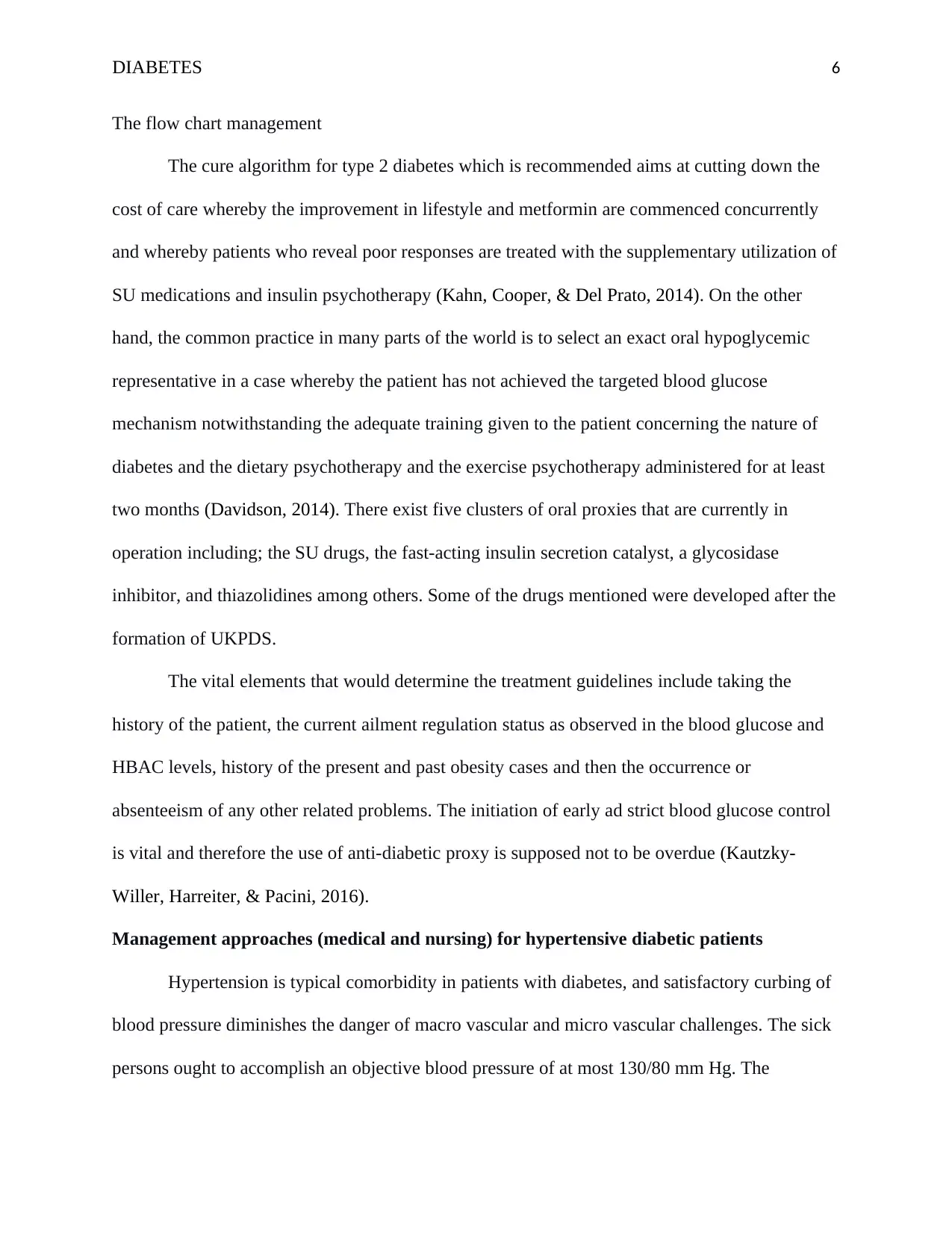
DIABETES 6
The flow chart management
The cure algorithm for type 2 diabetes which is recommended aims at cutting down the
cost of care whereby the improvement in lifestyle and metformin are commenced concurrently
and whereby patients who reveal poor responses are treated with the supplementary utilization of
SU medications and insulin psychotherapy (Kahn, Cooper, & Del Prato, 2014). On the other
hand, the common practice in many parts of the world is to select an exact oral hypoglycemic
representative in a case whereby the patient has not achieved the targeted blood glucose
mechanism notwithstanding the adequate training given to the patient concerning the nature of
diabetes and the dietary psychotherapy and the exercise psychotherapy administered for at least
two months (Davidson, 2014). There exist five clusters of oral proxies that are currently in
operation including; the SU drugs, the fast-acting insulin secretion catalyst, a glycosidase
inhibitor, and thiazolidines among others. Some of the drugs mentioned were developed after the
formation of UKPDS.
The vital elements that would determine the treatment guidelines include taking the
history of the patient, the current ailment regulation status as observed in the blood glucose and
HBAC levels, history of the present and past obesity cases and then the occurrence or
absenteeism of any other related problems. The initiation of early ad strict blood glucose control
is vital and therefore the use of anti-diabetic proxy is supposed not to be overdue (Kautzky-
Willer, Harreiter, & Pacini, 2016).
Management approaches (medical and nursing) for hypertensive diabetic patients
Hypertension is typical comorbidity in patients with diabetes, and satisfactory curbing of
blood pressure diminishes the danger of macro vascular and micro vascular challenges. The sick
persons ought to accomplish an objective blood pressure of at most 130/80 mm Hg. The
The flow chart management
The cure algorithm for type 2 diabetes which is recommended aims at cutting down the
cost of care whereby the improvement in lifestyle and metformin are commenced concurrently
and whereby patients who reveal poor responses are treated with the supplementary utilization of
SU medications and insulin psychotherapy (Kahn, Cooper, & Del Prato, 2014). On the other
hand, the common practice in many parts of the world is to select an exact oral hypoglycemic
representative in a case whereby the patient has not achieved the targeted blood glucose
mechanism notwithstanding the adequate training given to the patient concerning the nature of
diabetes and the dietary psychotherapy and the exercise psychotherapy administered for at least
two months (Davidson, 2014). There exist five clusters of oral proxies that are currently in
operation including; the SU drugs, the fast-acting insulin secretion catalyst, a glycosidase
inhibitor, and thiazolidines among others. Some of the drugs mentioned were developed after the
formation of UKPDS.
The vital elements that would determine the treatment guidelines include taking the
history of the patient, the current ailment regulation status as observed in the blood glucose and
HBAC levels, history of the present and past obesity cases and then the occurrence or
absenteeism of any other related problems. The initiation of early ad strict blood glucose control
is vital and therefore the use of anti-diabetic proxy is supposed not to be overdue (Kautzky-
Willer, Harreiter, & Pacini, 2016).
Management approaches (medical and nursing) for hypertensive diabetic patients
Hypertension is typical comorbidity in patients with diabetes, and satisfactory curbing of
blood pressure diminishes the danger of macro vascular and micro vascular challenges. The sick
persons ought to accomplish an objective blood pressure of at most 130/80 mm Hg. The
⊘ This is a preview!⊘
Do you want full access?
Subscribe today to unlock all pages.

Trusted by 1+ million students worldwide
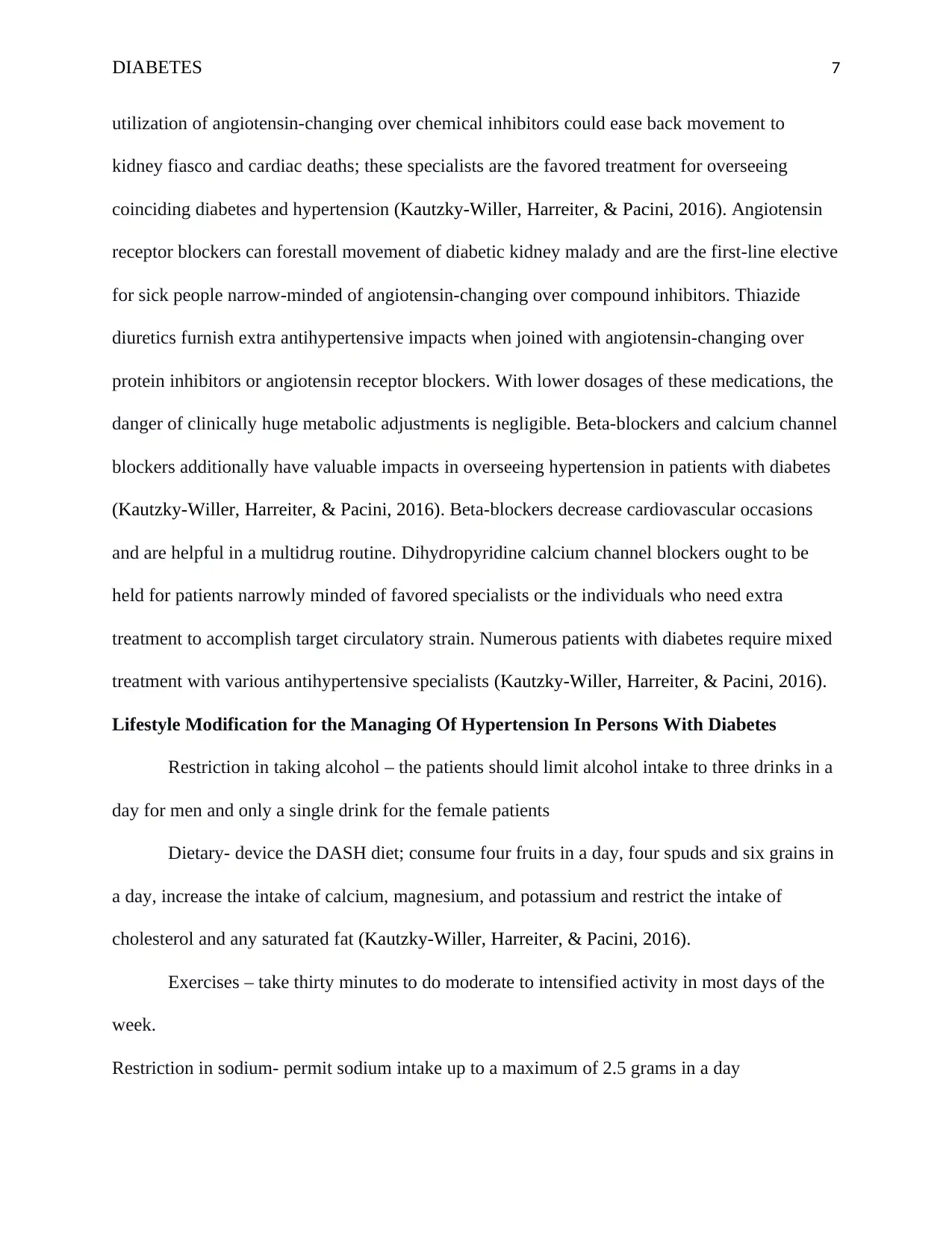
DIABETES 7
utilization of angiotensin-changing over chemical inhibitors could ease back movement to
kidney fiasco and cardiac deaths; these specialists are the favored treatment for overseeing
coinciding diabetes and hypertension (Kautzky-Willer, Harreiter, & Pacini, 2016). Angiotensin
receptor blockers can forestall movement of diabetic kidney malady and are the first-line elective
for sick people narrow-minded of angiotensin-changing over compound inhibitors. Thiazide
diuretics furnish extra antihypertensive impacts when joined with angiotensin-changing over
protein inhibitors or angiotensin receptor blockers. With lower dosages of these medications, the
danger of clinically huge metabolic adjustments is negligible. Beta-blockers and calcium channel
blockers additionally have valuable impacts in overseeing hypertension in patients with diabetes
(Kautzky-Willer, Harreiter, & Pacini, 2016). Beta-blockers decrease cardiovascular occasions
and are helpful in a multidrug routine. Dihydropyridine calcium channel blockers ought to be
held for patients narrowly minded of favored specialists or the individuals who need extra
treatment to accomplish target circulatory strain. Numerous patients with diabetes require mixed
treatment with various antihypertensive specialists (Kautzky-Willer, Harreiter, & Pacini, 2016).
Lifestyle Modification for the Managing Of Hypertension In Persons With Diabetes
Restriction in taking alcohol – the patients should limit alcohol intake to three drinks in a
day for men and only a single drink for the female patients
Dietary- device the DASH diet; consume four fruits in a day, four spuds and six grains in
a day, increase the intake of calcium, magnesium, and potassium and restrict the intake of
cholesterol and any saturated fat (Kautzky-Willer, Harreiter, & Pacini, 2016).
Exercises – take thirty minutes to do moderate to intensified activity in most days of the
week.
Restriction in sodium- permit sodium intake up to a maximum of 2.5 grams in a day
utilization of angiotensin-changing over chemical inhibitors could ease back movement to
kidney fiasco and cardiac deaths; these specialists are the favored treatment for overseeing
coinciding diabetes and hypertension (Kautzky-Willer, Harreiter, & Pacini, 2016). Angiotensin
receptor blockers can forestall movement of diabetic kidney malady and are the first-line elective
for sick people narrow-minded of angiotensin-changing over compound inhibitors. Thiazide
diuretics furnish extra antihypertensive impacts when joined with angiotensin-changing over
protein inhibitors or angiotensin receptor blockers. With lower dosages of these medications, the
danger of clinically huge metabolic adjustments is negligible. Beta-blockers and calcium channel
blockers additionally have valuable impacts in overseeing hypertension in patients with diabetes
(Kautzky-Willer, Harreiter, & Pacini, 2016). Beta-blockers decrease cardiovascular occasions
and are helpful in a multidrug routine. Dihydropyridine calcium channel blockers ought to be
held for patients narrowly minded of favored specialists or the individuals who need extra
treatment to accomplish target circulatory strain. Numerous patients with diabetes require mixed
treatment with various antihypertensive specialists (Kautzky-Willer, Harreiter, & Pacini, 2016).
Lifestyle Modification for the Managing Of Hypertension In Persons With Diabetes
Restriction in taking alcohol – the patients should limit alcohol intake to three drinks in a
day for men and only a single drink for the female patients
Dietary- device the DASH diet; consume four fruits in a day, four spuds and six grains in
a day, increase the intake of calcium, magnesium, and potassium and restrict the intake of
cholesterol and any saturated fat (Kautzky-Willer, Harreiter, & Pacini, 2016).
Exercises – take thirty minutes to do moderate to intensified activity in most days of the
week.
Restriction in sodium- permit sodium intake up to a maximum of 2.5 grams in a day
Paraphrase This Document
Need a fresh take? Get an instant paraphrase of this document with our AI Paraphraser
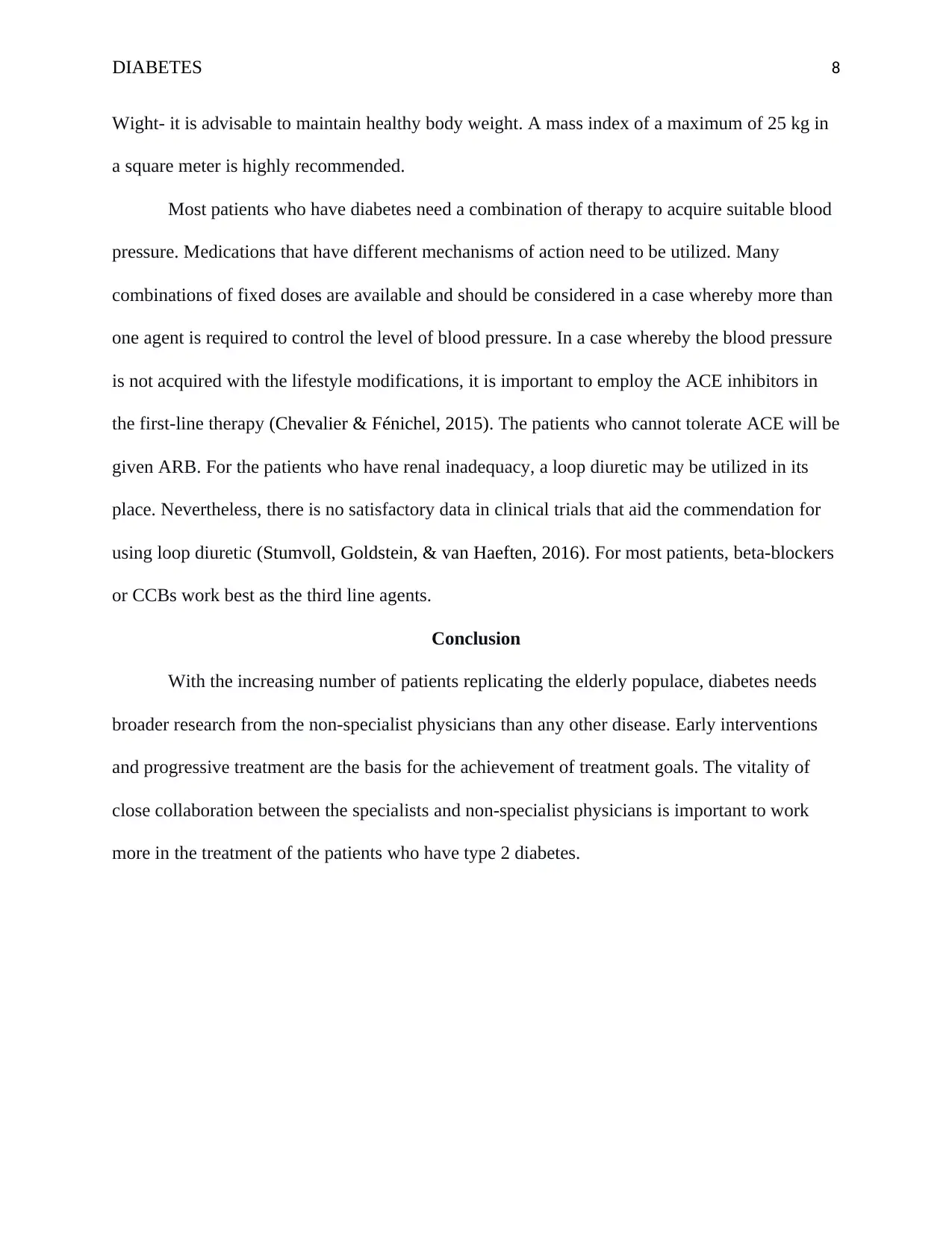
DIABETES 8
Wight- it is advisable to maintain healthy body weight. A mass index of a maximum of 25 kg in
a square meter is highly recommended.
Most patients who have diabetes need a combination of therapy to acquire suitable blood
pressure. Medications that have different mechanisms of action need to be utilized. Many
combinations of fixed doses are available and should be considered in a case whereby more than
one agent is required to control the level of blood pressure. In a case whereby the blood pressure
is not acquired with the lifestyle modifications, it is important to employ the ACE inhibitors in
the first-line therapy (Chevalier & Fénichel, 2015). The patients who cannot tolerate ACE will be
given ARB. For the patients who have renal inadequacy, a loop diuretic may be utilized in its
place. Nevertheless, there is no satisfactory data in clinical trials that aid the commendation for
using loop diuretic (Stumvoll, Goldstein, & van Haeften, 2016). For most patients, beta-blockers
or CCBs work best as the third line agents.
Conclusion
With the increasing number of patients replicating the elderly populace, diabetes needs
broader research from the non-specialist physicians than any other disease. Early interventions
and progressive treatment are the basis for the achievement of treatment goals. The vitality of
close collaboration between the specialists and non-specialist physicians is important to work
more in the treatment of the patients who have type 2 diabetes.
Wight- it is advisable to maintain healthy body weight. A mass index of a maximum of 25 kg in
a square meter is highly recommended.
Most patients who have diabetes need a combination of therapy to acquire suitable blood
pressure. Medications that have different mechanisms of action need to be utilized. Many
combinations of fixed doses are available and should be considered in a case whereby more than
one agent is required to control the level of blood pressure. In a case whereby the blood pressure
is not acquired with the lifestyle modifications, it is important to employ the ACE inhibitors in
the first-line therapy (Chevalier & Fénichel, 2015). The patients who cannot tolerate ACE will be
given ARB. For the patients who have renal inadequacy, a loop diuretic may be utilized in its
place. Nevertheless, there is no satisfactory data in clinical trials that aid the commendation for
using loop diuretic (Stumvoll, Goldstein, & van Haeften, 2016). For most patients, beta-blockers
or CCBs work best as the third line agents.
Conclusion
With the increasing number of patients replicating the elderly populace, diabetes needs
broader research from the non-specialist physicians than any other disease. Early interventions
and progressive treatment are the basis for the achievement of treatment goals. The vitality of
close collaboration between the specialists and non-specialist physicians is important to work
more in the treatment of the patients who have type 2 diabetes.
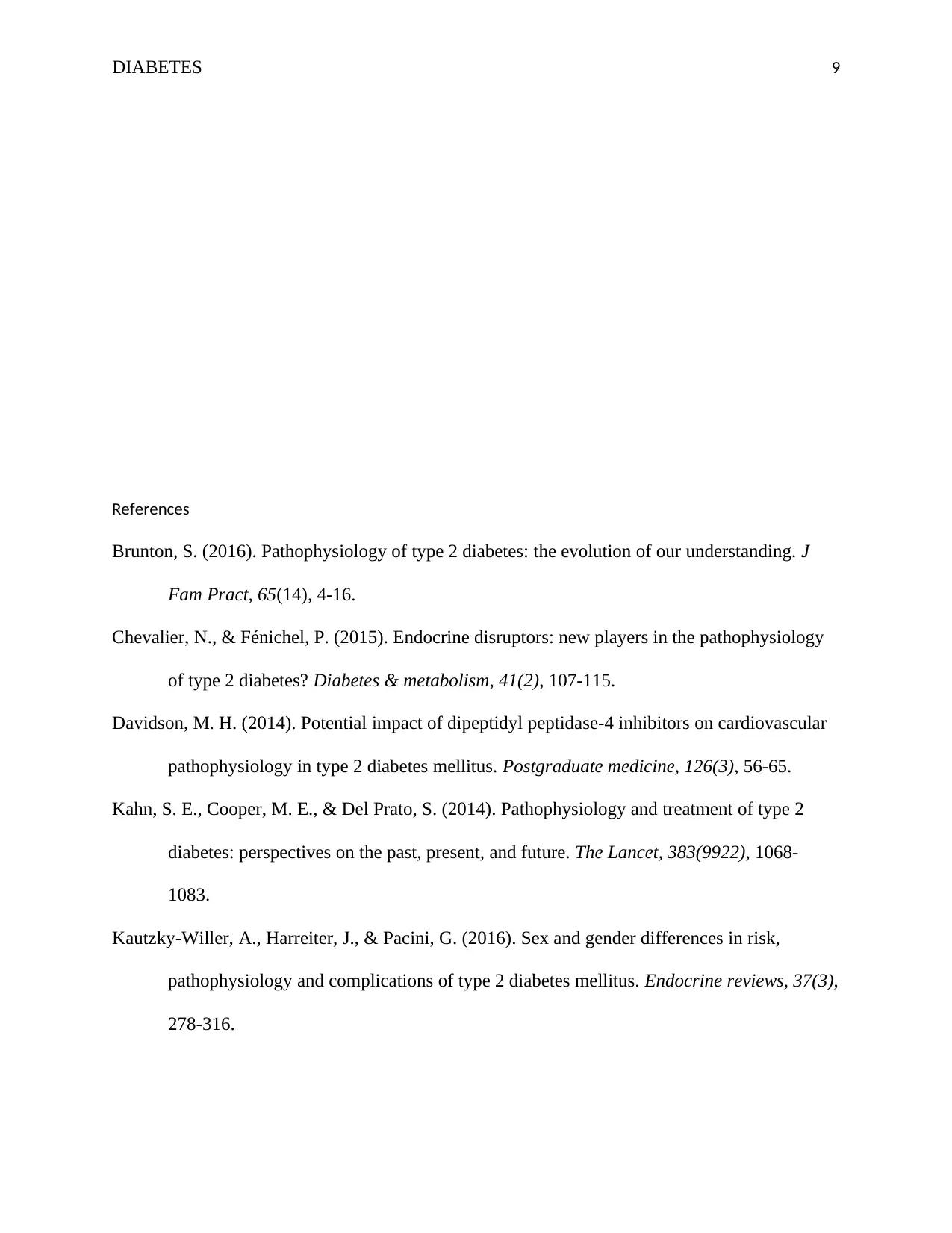
DIABETES 9
References
Brunton, S. (2016). Pathophysiology of type 2 diabetes: the evolution of our understanding. J
Fam Pract, 65(14), 4-16.
Chevalier, N., & Fénichel, P. (2015). Endocrine disruptors: new players in the pathophysiology
of type 2 diabetes? Diabetes & metabolism, 41(2), 107-115.
Davidson, M. H. (2014). Potential impact of dipeptidyl peptidase-4 inhibitors on cardiovascular
pathophysiology in type 2 diabetes mellitus. Postgraduate medicine, 126(3), 56-65.
Kahn, S. E., Cooper, M. E., & Del Prato, S. (2014). Pathophysiology and treatment of type 2
diabetes: perspectives on the past, present, and future. The Lancet, 383(9922), 1068-
1083.
Kautzky-Willer, A., Harreiter, J., & Pacini, G. (2016). Sex and gender differences in risk,
pathophysiology and complications of type 2 diabetes mellitus. Endocrine reviews, 37(3),
278-316.
References
Brunton, S. (2016). Pathophysiology of type 2 diabetes: the evolution of our understanding. J
Fam Pract, 65(14), 4-16.
Chevalier, N., & Fénichel, P. (2015). Endocrine disruptors: new players in the pathophysiology
of type 2 diabetes? Diabetes & metabolism, 41(2), 107-115.
Davidson, M. H. (2014). Potential impact of dipeptidyl peptidase-4 inhibitors on cardiovascular
pathophysiology in type 2 diabetes mellitus. Postgraduate medicine, 126(3), 56-65.
Kahn, S. E., Cooper, M. E., & Del Prato, S. (2014). Pathophysiology and treatment of type 2
diabetes: perspectives on the past, present, and future. The Lancet, 383(9922), 1068-
1083.
Kautzky-Willer, A., Harreiter, J., & Pacini, G. (2016). Sex and gender differences in risk,
pathophysiology and complications of type 2 diabetes mellitus. Endocrine reviews, 37(3),
278-316.
⊘ This is a preview!⊘
Do you want full access?
Subscribe today to unlock all pages.

Trusted by 1+ million students worldwide
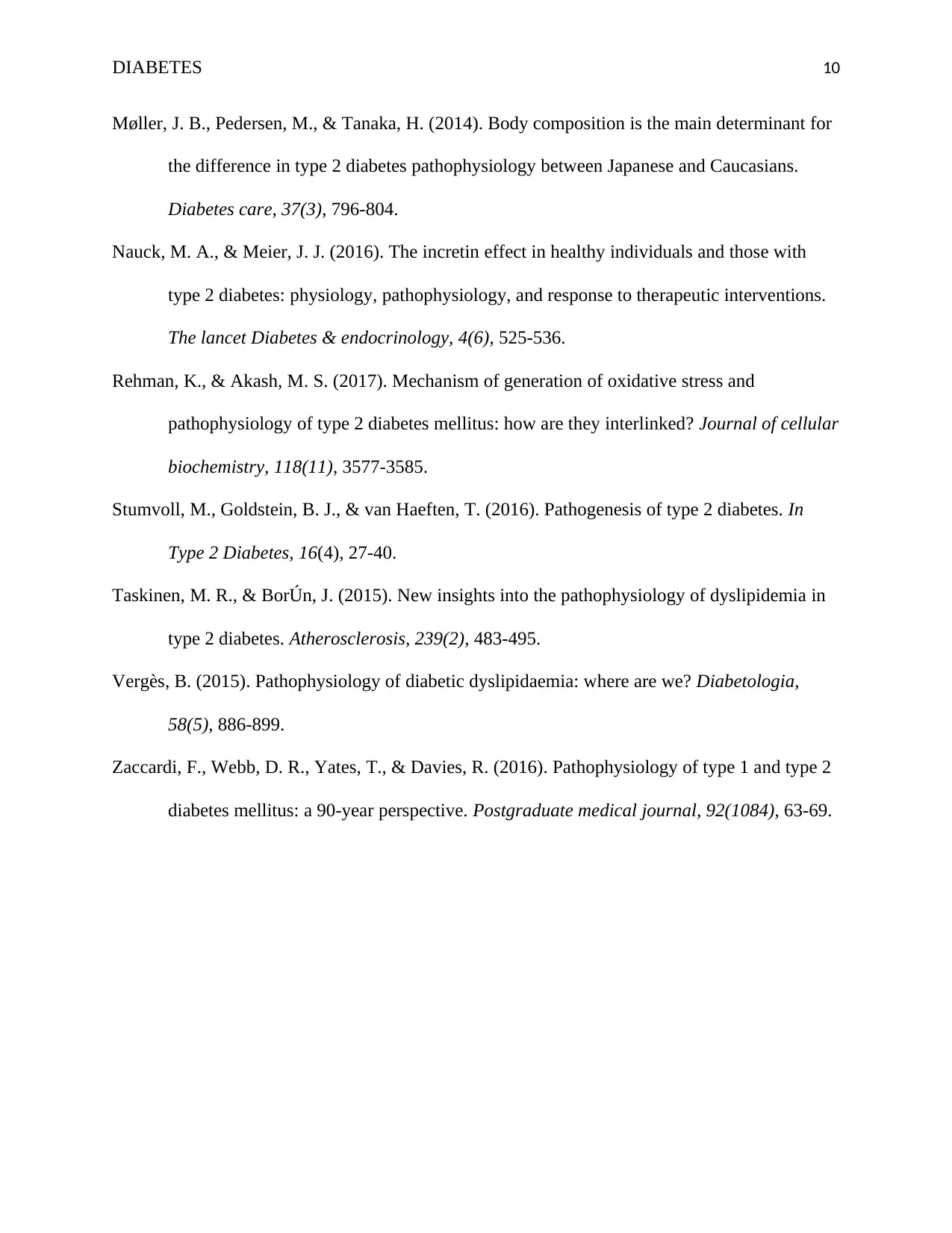
DIABETES 10
Møller, J. B., Pedersen, M., & Tanaka, H. (2014). Body composition is the main determinant for
the difference in type 2 diabetes pathophysiology between Japanese and Caucasians.
Diabetes care, 37(3), 796-804.
Nauck, M. A., & Meier, J. J. (2016). The incretin effect in healthy individuals and those with
type 2 diabetes: physiology, pathophysiology, and response to therapeutic interventions.
The lancet Diabetes & endocrinology, 4(6), 525-536.
Rehman, K., & Akash, M. S. (2017). Mechanism of generation of oxidative stress and
pathophysiology of type 2 diabetes mellitus: how are they interlinked? Journal of cellular
biochemistry, 118(11), 3577-3585.
Stumvoll, M., Goldstein, B. J., & van Haeften, T. (2016). Pathogenesis of type 2 diabetes. In
Type 2 Diabetes, 16(4), 27-40.
Taskinen, M. R., & BorÚn, J. (2015). New insights into the pathophysiology of dyslipidemia in
type 2 diabetes. Atherosclerosis, 239(2), 483-495.
Vergès, B. (2015). Pathophysiology of diabetic dyslipidaemia: where are we? Diabetologia,
58(5), 886-899.
Zaccardi, F., Webb, D. R., Yates, T., & Davies, R. (2016). Pathophysiology of type 1 and type 2
diabetes mellitus: a 90-year perspective. Postgraduate medical journal, 92(1084), 63-69.
Møller, J. B., Pedersen, M., & Tanaka, H. (2014). Body composition is the main determinant for
the difference in type 2 diabetes pathophysiology between Japanese and Caucasians.
Diabetes care, 37(3), 796-804.
Nauck, M. A., & Meier, J. J. (2016). The incretin effect in healthy individuals and those with
type 2 diabetes: physiology, pathophysiology, and response to therapeutic interventions.
The lancet Diabetes & endocrinology, 4(6), 525-536.
Rehman, K., & Akash, M. S. (2017). Mechanism of generation of oxidative stress and
pathophysiology of type 2 diabetes mellitus: how are they interlinked? Journal of cellular
biochemistry, 118(11), 3577-3585.
Stumvoll, M., Goldstein, B. J., & van Haeften, T. (2016). Pathogenesis of type 2 diabetes. In
Type 2 Diabetes, 16(4), 27-40.
Taskinen, M. R., & BorÚn, J. (2015). New insights into the pathophysiology of dyslipidemia in
type 2 diabetes. Atherosclerosis, 239(2), 483-495.
Vergès, B. (2015). Pathophysiology of diabetic dyslipidaemia: where are we? Diabetologia,
58(5), 886-899.
Zaccardi, F., Webb, D. R., Yates, T., & Davies, R. (2016). Pathophysiology of type 1 and type 2
diabetes mellitus: a 90-year perspective. Postgraduate medical journal, 92(1084), 63-69.
1 out of 10
Related Documents
Your All-in-One AI-Powered Toolkit for Academic Success.
+13062052269
info@desklib.com
Available 24*7 on WhatsApp / Email
![[object Object]](/_next/static/media/star-bottom.7253800d.svg)
Unlock your academic potential
Copyright © 2020–2025 A2Z Services. All Rights Reserved. Developed and managed by ZUCOL.





